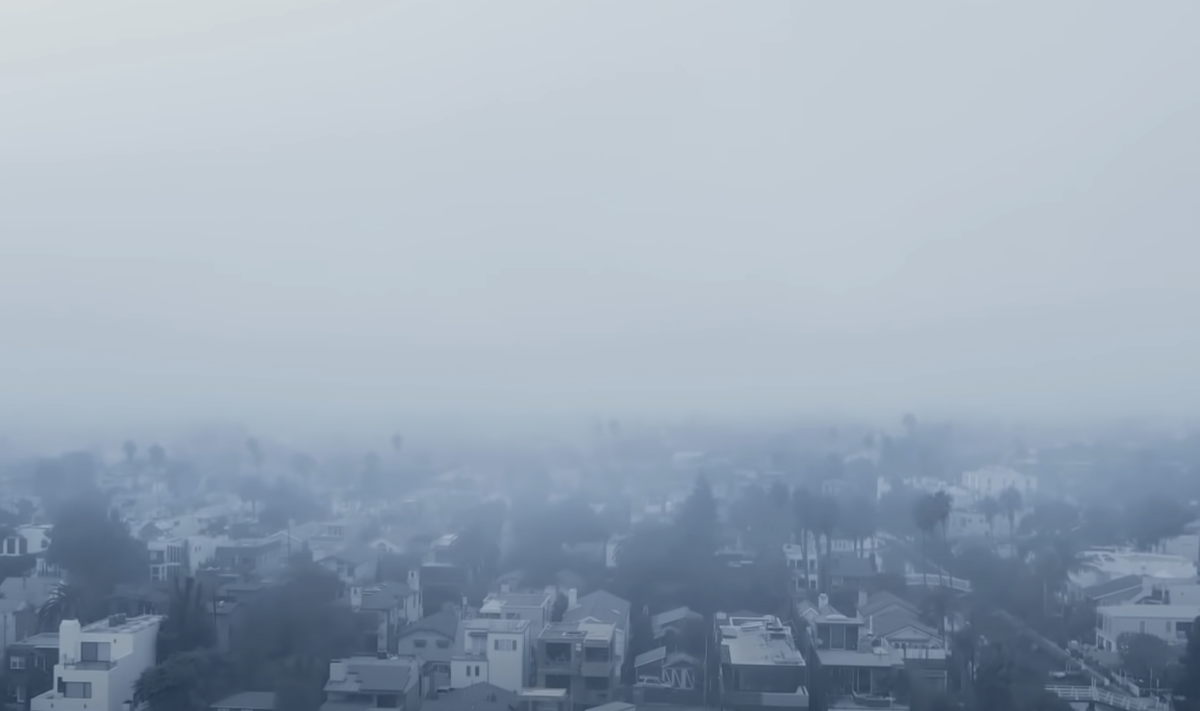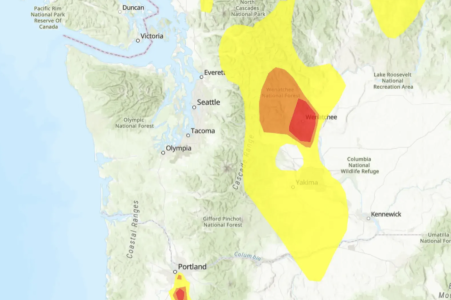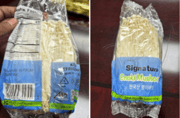
If the air around you suddenly looked foggy, would you know whether it was safe to breathe? That’s the question thousands of Americans are asking this week as parts of the country deal with heavy smoke, shifting winds, andrecord dry conditions that have made wildfire season harder to predict.
What began as a few isolated fires has now grown into a problem stretching across multiple counties—and while forecasts offer some hope, health officials are urging residents to stay alert.
The haze may look far away on a map, but its effects can travel much farther than most people realize.
Three large wildfires are continuing to burn across parts of Washington, pushing heavy smoke into nearby areas.
The Lower Sugarloaf, Labor Mountain, and Wildcat Fires have worsened air quality across Chelan and Douglas Counties, where readings have reached unhealthy and even hazardous levels in places like Wenatchee and Cashmere.
Further south, smaller pockets of polluted air have settled near Portland, affecting nearby towns such as Mulino and Liberal.
State officials are monitoring air movement closely as wind direction could shift the pattern at any time.
"There is no completely "safe" level of exposure to PM2.5."
Also read: Why this 233-year-old weather guide could be your secret weapon for winter travel planning
Why this smoke is so dangerous
Wildfire smoke isn’t just harmless haze—it’s filled with toxic compounds like benzene, formaldehyde, and heavy metals that are unsafe to breathe.
These fine particles, known as PM2.5, are small enough to travel deep into your lungs and even your bloodstream, according to environmental experts.
For adults over 60, this poses a special concern.
As people's lungs and heart grow more sensitive with age, prolonged exposure to PM2.5 can worsen conditions such as asthma, COPD, and heart disease.
Health officials recommend staying indoors, limiting outdoor activity, and checking air quality updates often during smoke events.
Understanding the air quality scale
The Air Quality Index (AQI) translates complex air data into a simple color-coded system to help you protect your health.
• 151–200 (Red): Unhealthy — everyone may start feeling effects.
• 201–300 (Purple): Very Unhealthy — serious risk for all groups.
• 301+ (Maroon): Hazardous — emergency conditions for everyone.
In parts of Central Washington, AQI readings have hovered between “Unhealthy” and “Very Unhealthy,” occasionally peaking into the “Hazardous” range—the highest category on the scale.
Also read: Thinking of moving? These 11 cities may have weather risks you’ll want to consider
Your home as a safe haven
When smoke fills the air, your home can become your best protection—if you prepare it properly.
The Washington Department of Ecology suggests choosing one room with minimal windows and doors as a “clean room.”
Seal gaps, close windows, and run an air purifier or a DIY clean air fan to keep pollution out.
If you don’t have a purifier, you can make one by taping a high-efficiency furnace filter to the back of a box fan.
Avoid activities like smoking, burning candles, or frying food, which can worsen indoor air quality.
Creating your clean room checklist
Choose a room with few windows and doors
Keep windows and exterior doors closed
Run air purifiers or DIY clean air fans
Avoid burning candles, cooking, or smoking indoors
Keep doors closed when not in use
Check and replace filters regularly
Also read:Weather alerts return in multiple languages after brief pause—here’s why it matters
Why this fire season is especially challenging
This year’s wildfire season has stretched longer than usual, driven by dry weather, reduced snowpack, and record-high temperatures across the Northwest.
According to Oregon’s Department of Environmental Quality, the result has been more days of unhealthy air quality and faster-moving fires.
The Lower Sugarloaf Fire alone has consumed over 42,000 acres.
The nearby Labor Mountain Fire has burned roughly 40,000 acres.
Firefighters are battling both blazes in steep terrain under difficult conditions that have fueled the persistent smoke blanketing the region.
Also read: Costco shoppers are rushing to grab these budget-friendly jackets before the weather turns
Signs of hope
Relief could be on the way.
Forecasters predict a chance of rain later this week, which could help calm the flames and improve air quality.
Cooler temperatures and increased humidity may also bring gradual improvement, though the exact timing remains uncertain.
Officials advise residents to continue monitoring air quality data through AirNow.gov and state environmental websites for real-time updates.
Also read:Cold weather myths exposed—what’s actually making you sick
When the air turns bad, community support matters
Extended smoke events can be isolating, especially for older adults living alone or those without air conditioning.
Washington health officials recommend checking in on neighbors who might be at risk.
A quick phone call or visit can make a difference for someone struggling with breathing difficulties or anxiety about the conditions.
If you know someone without clean air indoors, consider inviting them into your home’s clean room.
Many cities are also opening community centers with filtered air and cooling—contact your local emergency management office to find locations nearby.
What to expect next
Air quality alerts remain active “until further notice” across Chelan and Douglas Counties.
Because smoke patterns depend heavily on wind, visibility can look clear one moment and worsen dramatically the next.
Experts urge residents not to rely on appearance alone—air can still be hazardous even if skies look better.
Continue to check updates from AirNow, the Washington Department of Ecology, and your local health department until conditions stabilize.
Read next:
- Homeowners can save up to $83 a year with this simple “weather strip” trick—and it works year-round
- Could your air filter help lower blood pressure? Study says yes
- Air quality crisis declared in major US city—residents told to stay indoors
This situation affects all of us, but we're curious about your experience. Have you noticed changes in air quality where you live? What strategies have worked best for keeping your home's air clean during smoke events?
Share your tips and experiences in the comments below—your insights could help a neighbor stay safe.
Primary Source
https://www.newsweek.com/thousands-of-people-told-to-stay-indoors-in-two-states-10846207
It’s time to get #SmokeReady! - Washington State Department of Ecology
Cited text: For wildfire season 2025, the Washington Department of Natural Resources forecasts an above-average fire risk this year, due to a combination of droug...
Excerpt: 2025 has seen above-average fire risk due to drought conditions, reduced snowpack, and predicted high temperatures
https://ecology.wa.gov/blog/june-2025/it-s-time-to-get-smokeready
Washington Smoke Blog
Cited text: The Lower Sugarloaf, Labor Mountain, and Wildcat Fires continue to burn, producing significant smoke across portions of Central Washington.
Excerpt: The Lower Sugarloaf, Labor Mountain, and Wildcat Fires continue to burn, producing significant smoke across portions of Central Washington
Washington Smoke Blog
Cited text: Air quality is currently unhealthy to hazardous in Wenatchee and Cashmere, with visible smoke extending beyond the immediate fire zones.
Excerpt: air quality currently unhealthy to hazardous in Wenatchee and Cashmere
Washington Smoke Blog
Cited text: Air quality is currently unhealthy to hazardous in Wenatchee and Cashmere, with visible smoke extending beyond the immediate fire zones.
Excerpt: air quality currently unhealthy to hazardous in Wenatchee and Cashmere
Post - Newsroom
Cited text: Additionally, wildfire smoke contains a complex mixture of hazardous elements, things like formaldehyde, benzene, and even some heavy metals, which ar...
Excerpt: Wildfire smoke contains a complex mixture of hazardous elements, things like formaldehyde, benzene, and even some heavy metals, which are dangerous to breathe
https://apps.oregon.gov/oregon-news...asons-With-More-Days-of-Unhealthy-Air-Quality
OregonDEQ: 2025 Wildfire Smoke Trends Shows Longer Wildfire Season With More Unhealthy Air Quality | The Ashland Chronicle-Oregon
Cited text: Additionally, wildfire smoke contains a complex mixture of hazardous elements, things like formaldehyde, benzene, and even some heavy metals, which ar...
Excerpt: Wildfire smoke contains a complex mixture of hazardous elements, things like formaldehyde, benzene, and even some heavy metals, which are dangerous to breathe
https://theashlandchronicle.com/ore...dfire-season-with-more-unhealthy-air-quality/
It’s time to get #SmokeReady! - Washington State Department of Ecology
Cited text: Pick a room in your home and make it a “clean room.” This should be a room with fewer windows and outside doors.
Excerpt: Pick a room in your home and make it a "clean room." This should be a room with fewer windows and outside doors
https://ecology.wa.gov/blog/june-2025/it-s-time-to-get-smokeready
It’s time to get #SmokeReady! - Washington State Department of Ecology
Cited text: Shut all windows and doors, and run a DIY clean air fan or an air purifier.
Excerpt: Shut all windows and doors, and run a DIY clean air fan or an air purifier
https://ecology.wa.gov/blog/june-2025/it-s-time-to-get-smokeready
Washington Smoke Blog
Cited text: On a hopeful note, potential rain returns later this week.
Excerpt: Potential rain returns later this week
It’s time to get #SmokeReady! - Washington State Department of Ecology
Cited text: “Always consider checking up on neighbors and people in your life of higher risk,” said Doubleday.
Excerpt: Always consider checking up on neighbors and people in your life of higher risk
https://ecology.wa.gov/blog/june-2025/it-s-time-to-get-smokeready







